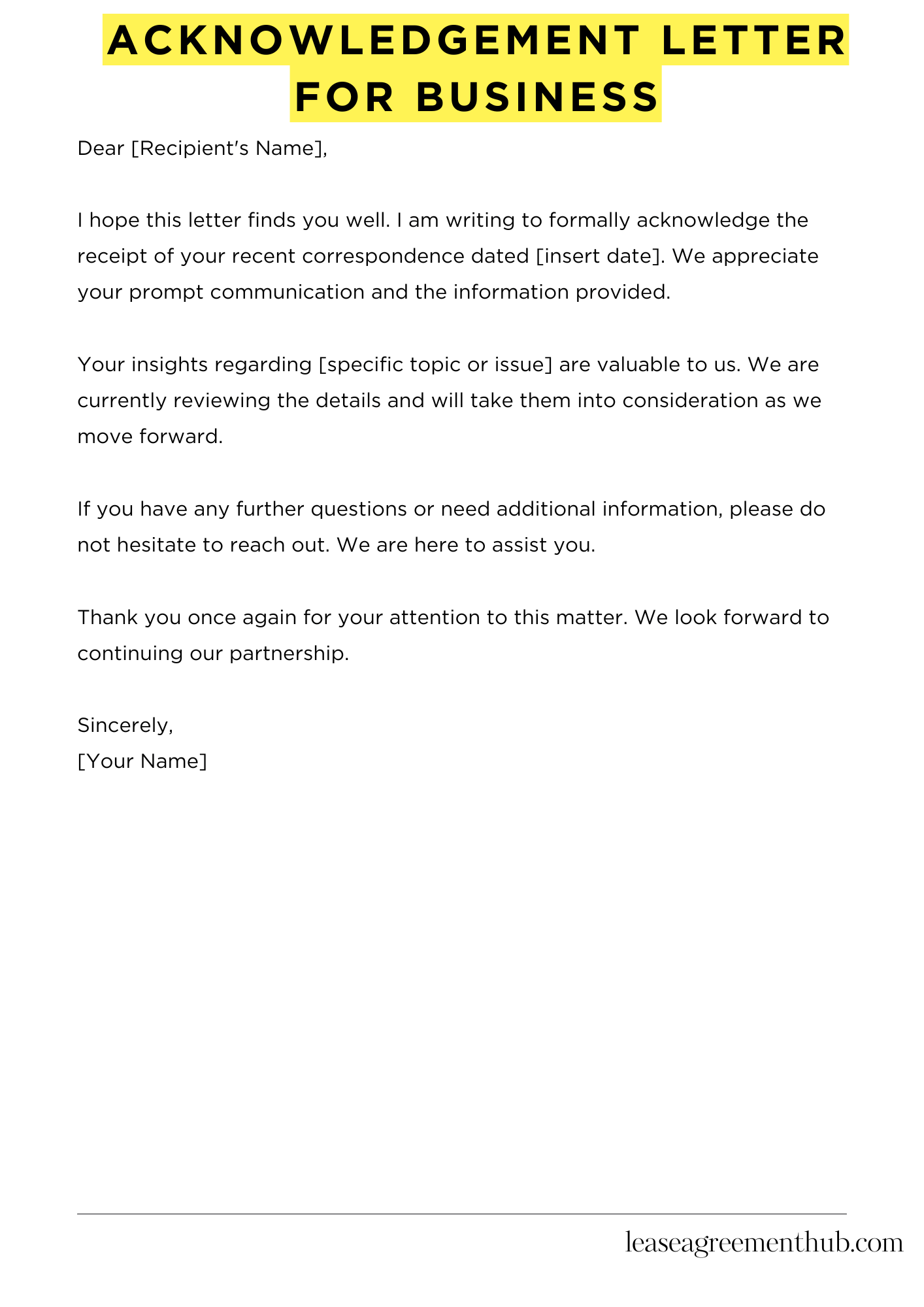An Acknowledgement Letter for Business is a formal document that confirms the receipt of goods, services, or information. Its main purpose is to provide assurance to the sender that their correspondence or delivery has been received and noted. This letter helps maintain clear communication and strengthens professional relationships.
In this article, we will share various templates and examples of Acknowledgement Letters for Business. These samples will guide you in crafting your own letters quickly and effectively. Whether you need to acknowledge a payment, a proposal, or any other business matter, we have you covered.
Our goal is to make it easy for you to find the right words. With our ready-to-use templates, you can save time and ensure your letters are professional. Let’s dive into the samples and help you write your Acknowledgement Letter with confidence.
Acknowledgement Letter For Business
[Your Name]
[Your Position]
[Your Company Name]
[Company Address]
[City, State, Zip Code]
[Email Address]
[Phone Number]
[Date]
[Recipient’s Name]
[Recipient’s Position]
[Recipient’s Company Name]
[Company Address]
[City, State, Zip Code]
Dear [Recipient’s Name],
I hope this letter finds you well. I am writing to formally acknowledge the receipt of your recent correspondence dated [insert date]. We appreciate your prompt communication and the information provided.
Your insights regarding [specific topic or issue] are valuable to us. We are currently reviewing the details and will take them into consideration as we move forward.
If you have any further questions or need additional information, please do not hesitate to reach out. We are here to assist you.
Thank you once again for your attention to this matter. We look forward to continuing our partnership.
Sincerely,
[Your Name]

How to Write an Acknowledgement Letter for Business
In the fast-paced world of business, clear and concise communication is essential. Acknowledgement letters, though seemingly simple, play a crucial role in maintaining professional relationships and ensuring smooth operations. They serve as a formal confirmation of receipt, providing a written record of your understanding and commitment.
Understanding the Purpose
An acknowledgement letter is not just a formality. It serves several important purposes:
- Confirmation of Receipt: It confirms that you have received a specific document, request, or communication. This is crucial for legal and administrative purposes.
- Professional Courtesy: It demonstrates your professionalism and respect for the sender. A timely acknowledgement shows that you value their communication.
- Setting Expectations: It can outline the next steps or provide a timeline for action, setting clear expectations for both parties.
- Building Relationships: A well-written acknowledgement letter can strengthen your relationship with clients, suppliers, or colleagues.
Essential Elements of an Acknowledgement Letter
While the content will vary depending on the specific situation, a standard acknowledgement letter should include the following elements:
- Your Name and Contact Information: Include your full name, company name, address, phone number, and email address.
- Date: Clearly state the date the letter is written.
- Recipient’s Name and Contact Information: Include the recipient’s name, company name, address, and any relevant contact details.
- Subject Line: A clear and concise subject line, such as “Acknowledgement of [Document/Request/Communication],” helps the recipient quickly understand the purpose of the letter.
- Acknowledgement Statement: This is the core of the letter. State clearly and concisely that you have received the specific document, request, or communication.
- Next Steps or Timeline: If applicable, outline the next steps or provide a timeline for action. This helps manage expectations and ensures a smooth workflow.
- Closing and Signature: End the letter with a professional closing, such as “Sincerely” or “Best regards,” followed by your typed name and handwritten signature.
Tips for Writing Effective Acknowledgement Letters
To ensure your acknowledgement letters are clear, concise, and impactful, consider these tips:
- Be Prompt: Respond to communications promptly. Delaying an acknowledgement can create unnecessary confusion or delay the process.
- Be Specific: Clearly identify the document, request, or communication you are acknowledging. Avoid vague or ambiguous language.
- Be Professional: Maintain a professional tone throughout the letter. Avoid using slang or informal language.
- Be Concise: Keep your letter brief and to the point. Avoid unnecessary details or rambling.
- Be Positive: Express your appreciation for the communication and your willingness to work together.
Examples of Acknowledgement Letters
Here are some examples of acknowledgement letters for different situations:
- Acknowledgement of a Purchase Order: This type of letter confirms receipt of a purchase order and outlines the next steps, such as order processing and delivery.
- Acknowledgement of a Complaint: This letter acknowledges receipt of a complaint and outlines the steps you will take to address it.
- Acknowledgement of a Job Application: This letter confirms receipt of a job application and may provide information about the next steps in the hiring process.
Conclusion
Acknowledgement letters are an essential tool for effective business communication. By following these guidelines, you can craft clear, concise, and professional letters that strengthen relationships, maintain smooth operations, and ensure everyone is on the same page.
Related: